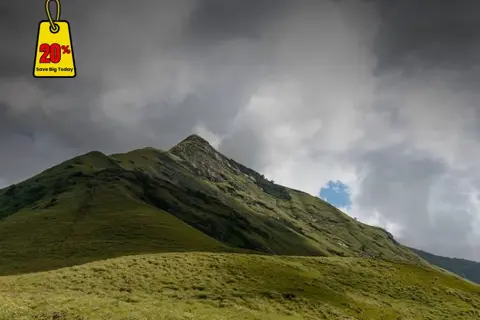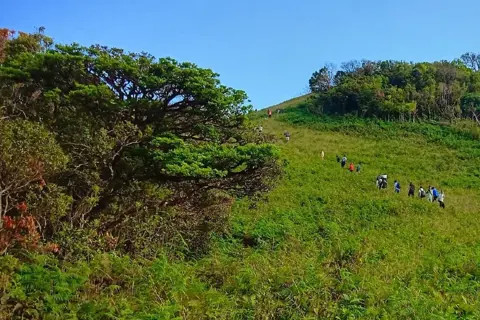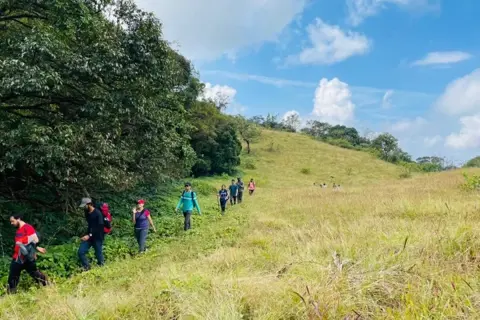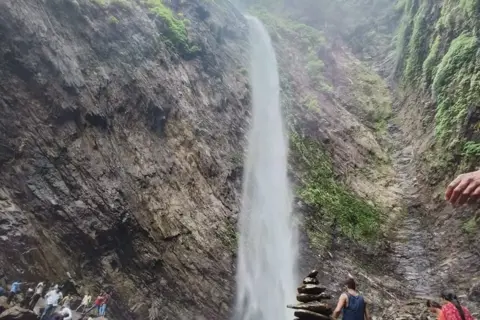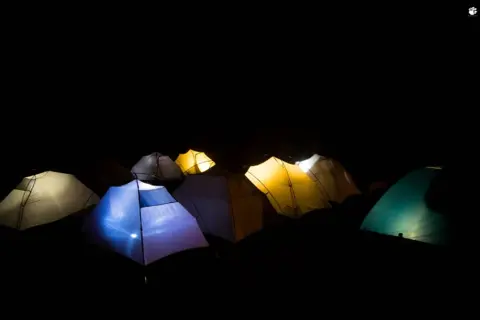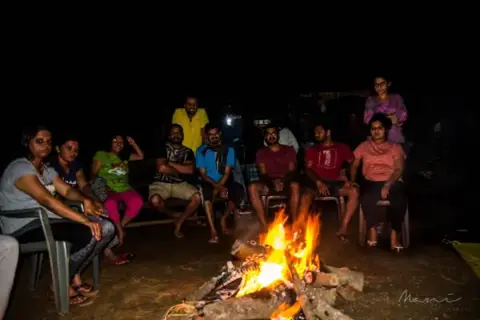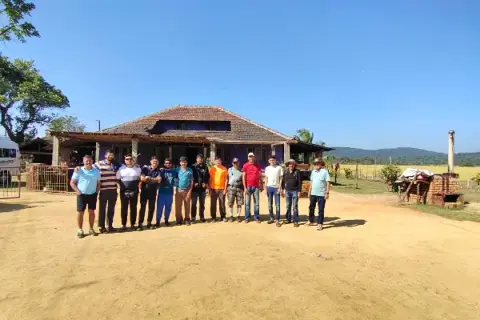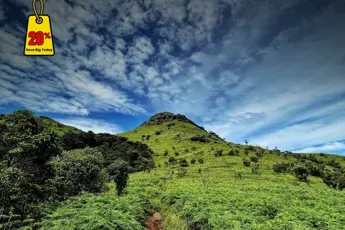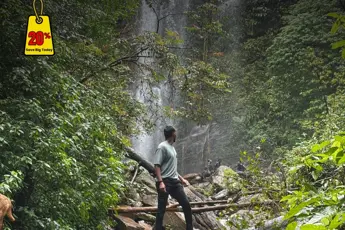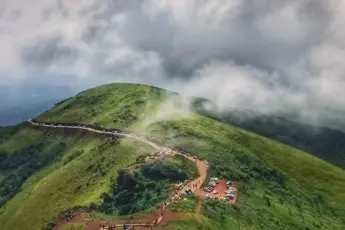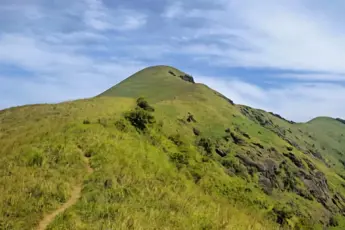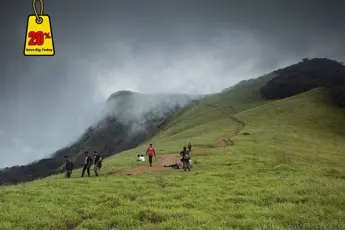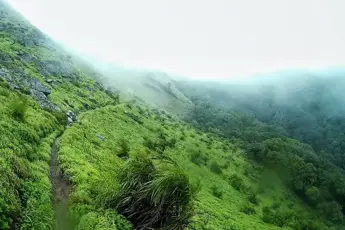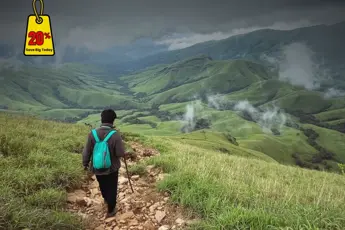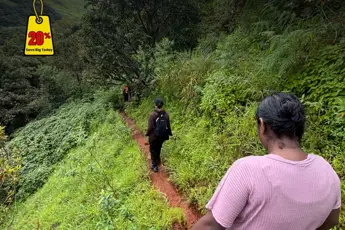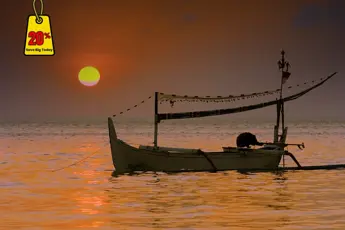Narasimha Parvatha or Agumbe Peak is among Karnataka's Western Ghat’s most beautiful and challenging trekking destinations. It is about 1,150 meters (3,773 feet) above sea level, the top of the Agumbe range, and offers breathtaking panoramic views of dense forests, rolling hills, and foamy waterfalls. The ascension to the peak is well-known for the rolling landscape, dense cover of woods, rich vegetation and fauna, and hence a paradise for nature enthusiasts and adventure enthusiasts.The hill is also named after Lord Narasimha, an avatar of Lord Vishnu, and has become a regional tourist spot. Narasimha Parvatha is also a part of the Someshwara Wildlife Sanctuary, hence being even more biodiverse. Trekkers and climbers walk the whole distance to this hill just to take the risk of climbing but also to enjoy the pristine view of the Western Ghats, which has also been made a UNESCO World Heritage Site due to its biodiversity.Best Time to Visit Narasimha Parvatha:Winter Season (Jan to Mar):Ideal for trekking, with weather ranging from 15°C to 25°C.Clear skies and great visibility of hills and valleys.Less slippery trails and good for wildlife and bird viewing.Post-Monsoon (Oct to Dec):Best for trekking.Lush green landscape, waterfalls in full flow.Misty mountains and pleasant weather, perfect for nature lovers and photographers.Monsoon (Jun to Sep):Landscape is stunning with waterfalls and greenery.Trails are slippery, and leeches are prevalent.Not ideal for trekking unless well-prepared and experienced.Summer (Apr to May):Not recommended due to high temperatures (up to 35°C).Trekking can be exhausting, but early mornings can be manageable.Good for avoiding tourist crowds.Trekking Route and Trail DetailsIndian trekking is an adventurous activity with varied landscapes ranging from rolling hills and woods to mountain paths and valley mists. Among them, Agumbe and Kigga are famous for their natural beauty in their raw state, diversity of flora and fauna, and rugged terrain.Karnataka Western Ghats treks offer a series of challenges to beginners and experienced trekkers alike. Here below is a detailed guide to the trekking routes of these places, including distance, difficulty levels, and trekking duration, along with trekking tips and the best time to visit for trekking.Trekking Routes and Route DetailsAgumbe Trek: Agumbe, or "South's Cherrapunji," is famous for its rainforest landscape, stunning sunsets, and abundance of wildlife. A few of the trekking routes of the place, with a special experience, are available.Barkana Falls TrekDistance: 6 km (one way)Difficulty Level: ModerateDuration: 4-5 hoursDescription: A trek to Barkana Falls is a trek through dense forests leading to the stunning sight of one of the tallest waterfalls in India. The trek has flowers and fauna in between and the trekker has sporadic views of endemics and small mammals.Kudlu Theertha Falls TrekDistance: 7 km (one way)Difficulty Level: ModerateDuration: 5-6 hoursDescription: The trek is to a great waterfall, which is within the dense forest. The bottom of the falls is a nice spot to relax with a splash of water, and trekkers come to this location time and again for leisure and relaxation.Narasimha Parvatha Trekdistance: 13 km (one way)difficulty Level: Difficultduration: 7-8 hoursDescription: The Agumbe Peak with an exhilarating trekking experience on dense forest trails, grasslands, and rocky ground. The peak satisfies one with breathtaking views of the Western Ghats and is a tough trekking experience for experienced trekkers.Kigga Trek: Kigga is a small but ancient Sringeri village renowned for its ancient temple as well as scenic trekking trails to some of Karnataka's most scenic places.Sirimane Falls Trekdistance: 5 km (one way)difficulty Level: Easyduration: 2-3 hoursDescription: Easy and brief trek for newbies as well as families. This is to the lovely Sirimane Falls through the green surroundings where visitors can relax somewhat in the serene surroundings.Kundadri Hills TrekDistance: 3 km (one way)Difficulty Level: Easy to ModerateDuration: 1-2 hoursDescription: For the trekking enthusiasts but a shorter one but an experience still. Kundadri Hills provide sunrise and sunset views that are just breathtaking and is a destination that needs to be explored by nature lovers and photographers too.Kodachadri Trek (Kigga Route)distance: 15 km (one way)difficulty level: Moderate to Toughduration: 7-9 hoursDescription: Karnataka's most sought-after trek, the Kodachadri trek is a mix of open ridges, waterfalls, and forest trails. The view from the summit is breathtaking with rolling hills as far as the eye can see.Key Trekking Guidelines and TipsPreparation: Always prepare beforehand for the trek, i.e., weather, difficulty, and distance.Fitness: Ensure you are fit, especially for long or difficult treks.Packing Must-Haves: Having a rugged backpack with the bare necessities of water bottles, energy bars, rainwear, a first-aid kit, and a flashlight.Shoes: Good quality and sturdy trekking shoes with proper grip.Clothing: Dressing in layers and sporting moisture-wicking clothing to be warm and dry.Navigation: Bringing a map, GPS, or having offline maps in your phone on the trekking route.Precautions for Safety: Always inform someone of your trekking path and never go alone to new trails.Conservation of the Environment: Keep a 'Leave No Trace' attitude—don't litter, don't harm nature, and don't harass wildlife.Water and Food: Carry sufficient water and have snacks like nuts, protein bars, and dry fruits that provide energy.Best Time to TrekThe best period for trekking in Agumbe, Kigga, and other regions of Western Ghats is based on what kind of experience you are seeking.Post-Monsoon (September-February): This is the best season to trek as the weather is pleasant, and the scenery is lush and full of vegetation post-rains in the monsoon season. The waterfalls are at their peak, and the scenery is just beautiful.Winter (December to February): The cold enough weather is ideal for lengthy treks, and good clear weather visibility offers wide clean visions of the surroundings to delight the trekkers.Summer (March to May): Despite being open throughout, it's not convenient for daytime due to the heat. Early morning time is trekkers' best-loved season to avoid the searing sunshine by day.Monsoon (June to August): Monsoon treks are dangerous with slippery tracks, leeches, and rains. But for monsoon enthusiasts, safer and shorter treks can be done with caution.Sunset Point and Tourist spots around AgumbeThe most thrilling experience in Agumbe is witnessing the sunset at the famous Agumbe Sunset Point. Just a few minutes drive from the village, the point provides a stunning panoramic view of the Arabian Sea on a clear day.Seeing the sun go below the horizon, creating golden and reddish hues over the Western Ghats, is an excellent experience for nature lovers and photographers. Apart from Sunset Point, Agumbe also boasts other nature and cultural tourist destinations nearby that complement its even greater grandeur and beauty.Some of them are visit-worthy:Jogigundi Falls – A quiet waterfall surrounded by thick forests, ideal for a simple hike and a splash of freshness.Barkana Falls – It is among the highest waterfalls in Karnataka which drops 850 feet, offering a stunning view of the valley.Onake Abbi Falls – A hidden waterfall for a challenging jungle hike that's best suited for the adventurous.Kundadri Hill – A hilltop with a very ancient Jain temple with a great sunrise and set view.Someshwara Wildlife Sanctuary – Provides diversified wild animals like elephants, leopards, and exotically coloured birds to live and hence is most suitable for wildlife photographers and tourists.Sringeri Sharada Peetham – A well-known Hindu pilgrim centre in the name of Goddess Sharada founded by Adi Shankaracharya.Agumbe Rainforest Research Station (ARRS) – A spot that needs to be seen by wildlife research students and nature conservators as well.Attractions Around AgumbeSringeri Sharada Peetham:One of South India’s holiest pilgrimage sites, established by Adi Shankaracharya.Famous for its spiritual atmosphere, carved architecture, and serene surroundings.Notable features: 12 zodiac pillars and sacred fish in the Tunga River.Celebrations: Navaratri and Vasantotsavam.Barkana Falls:A stunning 850-feet waterfall near Agumbe.Best visited from June to September during the non-monsoon months.Accessible via a 6–7 km hike through Someshwara Wildlife Sanctuary.Great for nature lovers and photographers.Onake Abbi Falls:A hidden gem near Agumbe, known for its stick-like water plunge.The 5 km trek is surrounded by thick forests, birds, and wildlife.Ideal for meditation, photography, or peaceful rest.Kundadri Hills:A 3,200-foot hill with an ancient Jain temple dedicated to Parshvanatha.Famous for its breathtaking sunrise and sunset views.Accessible by trekking or driving through dense forests.Kavaledurga Fort:An ancient fort built in the 9th century AD, further fortified by the Keladi kings in the 16th century.Features include ruins of temples and palaces and a panoramic view of the Western Ghats.Ideal for history enthusiasts and trekkers, especially in winter or monsoon.Challenges and Precautions for TrekkersTrekking is one of the most thrilling outdoor adventure sports, offering adventure enthusiasts an opportunity to experience nature in all its glory. Nevertheless, it is not without danger and issues. Ranging from harsh climatic conditions to fatigue and navigational challenges, trekkers have to be properly equipped to confront whatever awaits them on their journey through their travel.In this tutorial, we will be discussing the general issues encountered during the trek, preliminary safety precautions, emergency contact points, and permissions from the forest department.Common Difficulties Faced During the TrekUnpredictable Weather Conditions: Weather in mountains and forests is highly unpredictable. Trekkers may experience sudden rain, extreme cold, heavy snowfall, or even heat waves depending on location and season. All these can cause hypothermia, dehydration, or heatstroke if precautions are not taken.Altitude Sickness: Altitude sickness (Acute Mountain Sickness - AMS) is a frequent issue for individuals trekking at high altitudes. Symptoms include nausea, headache, dizziness, breathlessness, and lethargy. The disease, if not rectified, can further progress to serious conditions such as High-Altitude Pulmonary Edema (HAPE) or High-Altitude Cerebral Edema (HACE), which can be life-threatening.Physical Fatigue and Injuries: Trekking is a day's walking on uneven and often steep ground. This can cause muscle cramps, blisters, sprains, or even fractures. Physical unfitness can make the trek much harder and riskier.Navigation and Getting Lost: The treks are poorly sign-posted, and trekkers get lost due to bad navigation. This is more common in hill or forest regions where points of reference are not readily available. Failure of proper maps or GPS guidance may cause one to lose direction as to what is the right track.WildLife Encounters: Walking on forest trails translates to encounters with wildlife like snakes, bears, leopards, and other hostile wild animals. Insects and leeches are also a feature of tropical journeys and can be unpalatable or infectious unless properly checked.Lack of Water and Food: Remote expeditions typically lack a clean drinking water source and food supply. Dirty water sources can cause stomach diseases and dehydration, and inadequate food supply can reduce energy levels drastically.Communication Barriers: One cannot communicate outside the trekking remote areas as mobile network signals are weak or absent in the majority of these areas. It is a huge disappointment in emergencies when immediate help is needed by the trekkers.Safety Measures for TrekkersProper Planning and Preparations: One must research the trek, know the intensity level, and check the weather conditions prior to setting out for a trek. Having a chart or GPS would avoid getting lost.Minimal Trekking Gears: Some essentials that should be carried along by every visitor include clothes of proper quality, trek shoes, a rucksack, a first aid kit, a rain jacket, a flashlight, and an extra battery. A Trek pole is also helpful in maintaining balance over uneven trails.Nutrition and Hydration: Supply of water and water purification tablets should be on hand. Dried fruits, energy bars, and protein-rich snacks can help sustain energy and supply necessary nutrients in longer walking distances.Acclimatization for High-Altitude Treks: Above 2500 meters, the body needs time to acclimatize, and rest days, plenty of water, and no alcohol are a must. Steady climbing and not exceeding 300-500 meters a day prevents altitude sickness.Group Trekking: It is not safe to trek alone, especially in remote places. Travelling in groups is safe, and if something happens, other climbers will be ready to rescue the trekkers. Having a guide can be a huge benefit.Emergency Contact Points: Trekkers should know the location of the closest rescue centres, forest department offices, and hospitals. A whistle, a mirror, or a distress flare must be carried to signal in case of any emergency. Satellite telephones or emergency radio booths are available in some areas where help can be called for.Wildlife Safety Precautions: Avoid disturbing, scaring off animals, or approaching their habitats at night. Insect repellent and long sleeves will be bug-bite protective. Food should be stored in sealed containers and animals excluded from the campsite.First Aid and Medical Precautions: One must have a well-stocked first aid kit with antiseptic, painkillers, bandages, and general medicines. All trekkers with previous medical ailments should consult a doctor before the trek and take medicines accordingly.Forest Department Permissions and Entry RestrictionsIn all three zones, trek routes are going through national parks, wildlife sanctuaries, and forest reserves, and prior approval is needed from the forest department. Some of the most important facts to note are:Permit Requirements: A permit for almost all areas of trekking is necessary, and it can be acquired from either the local office of tourism or the forest office. Permits control the trekkers and maintain the ecosystem safe.Entry Fee and Restriction: There is an entry fee for some national parks and reserves. Some trekking sites have restricted entry that can be permitted during certain seasons due to wildlife breeding or conservation activities.Camping Laws: The majority of forest areas have campsites where camps must be erected by the trekkers. Campfires may be banned to prevent forest fires, and litter disposal laws must be obeyed strictly.Eco-Friendly Trekking Policies: The trekkers must adopt a 'Leave No Trace' culture, no littering, no killing of fauna and flora, and no invasion of nature. Carrying biodegradable bags and cleaning up waste is strongly encouraged.Group Size Restrictions and Timings for Trekking: Pre-scheduled timings are fixed on some trekking routes, and night trekking is banned due to safety concerns. Group size is restricted in some places to prevent damage to the environment.Local Guides and Compulsory Registrations: In certain regions, a local guide is compulsory to be hired due to safety reasons. The trekking parties may also have to register when they leave and sign back in when they return to make sure that all the trekkers have returned safely.Prohibition of Activities: It is forbidden to hunt, bear arms, pick flowers, or disturb wildlife in the reserve areas. Violation will entail a substantial penalty or judicial proceeding by the forest department.How to Reach Narasimha Parvatha:By Air:Nearest airport: Mangalore International Airport (IXE) – 135 km away.Connected to major cities like Bangalore, Mumbai, and Chennai.Taxi or bus to Agumbe/Kigga, trekking base points.By Rail:Nearest station: Udupi Railway Station – 90 km away.Connected via Konkan Railway.Alternative: Shimoga Railway Station – 110 km away.By Road:From Bangalore (350 km): Via NH 75 through Hassan, Chikmagalur, and Sringeri to Agumbe.From Mangalore (135 km): Via NH 169 through Karkala, Hebri, and Agumbe.KSRTC/private buses run from Bangalore, Mangalore, and Udupi to Agumbe/Sringeri.Jeeps/taxis available to Kigga or Mallandur for trekking.ConclusionFor those who want to make this experience even more special, consider booking your trip with escapes2explore. They offer organized treks that ensure a hassle-free and memorable adventure. Happy trekking!







